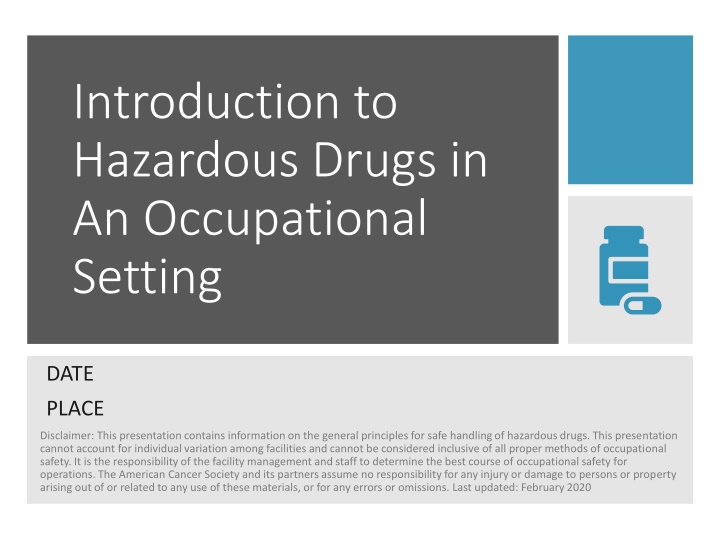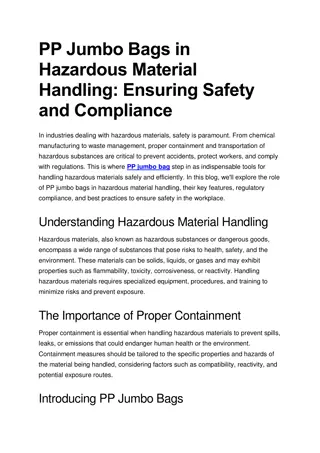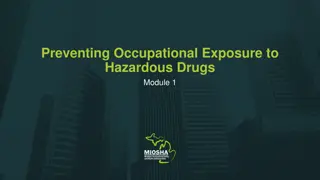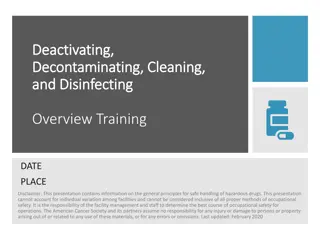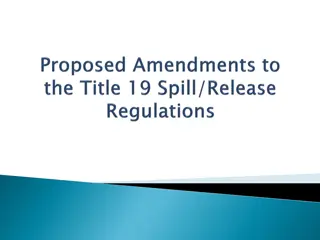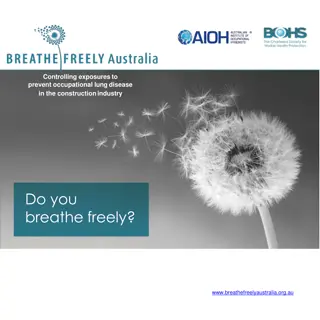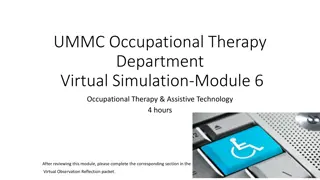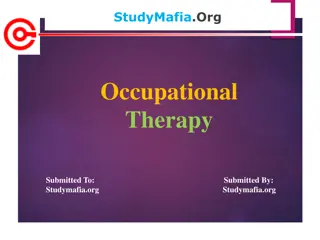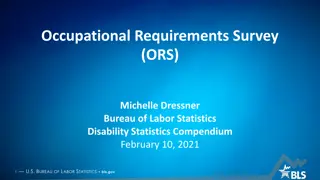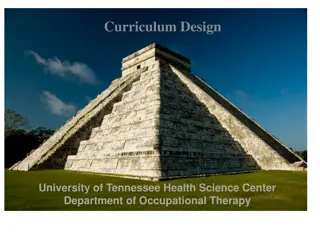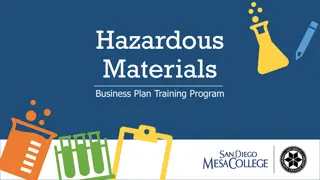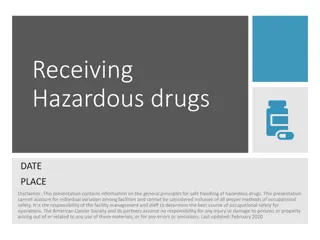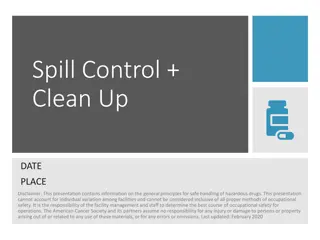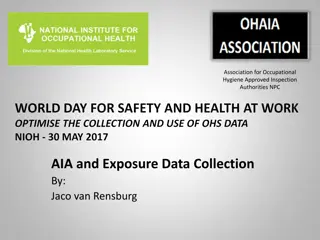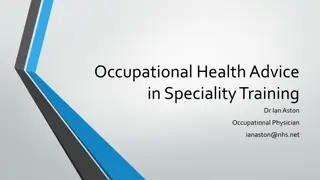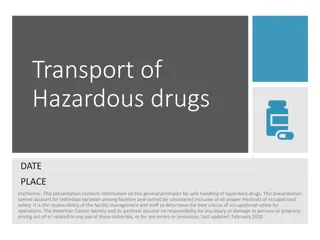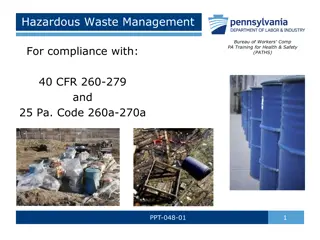Introduction to Hazardous Drugs in An Occupational Setting
Presentation on safe handling of hazardous drugs in occupational settings, covering criteria for hazardous drugs, routes of exposure, interventions to reduce exposure, and more. Includes information on what constitutes a hazardous drug, its risks, and proper handling procedures.
Download Presentation

Please find below an Image/Link to download the presentation.
The content on the website is provided AS IS for your information and personal use only. It may not be sold, licensed, or shared on other websites without obtaining consent from the author.If you encounter any issues during the download, it is possible that the publisher has removed the file from their server.
You are allowed to download the files provided on this website for personal or commercial use, subject to the condition that they are used lawfully. All files are the property of their respective owners.
The content on the website is provided AS IS for your information and personal use only. It may not be sold, licensed, or shared on other websites without obtaining consent from the author.
E N D
Presentation Transcript
Introduction to Hazardous Drugs in An Occupational Setting DATE PLACE Disclaimer: This presentation contains information on the general principles for safe handling of hazardous drugs. This presentation cannot account for individual variation among facilities and cannot be considered inclusive of all proper methods of occupational safety. It is the responsibility of the facility management and staff to determine the best course of occupational safety for operations. The American Cancer Society and its partners assume no responsibility for any injury or damage to persons or property arising out of or related to any use of these materials, or for any errors or omissions. Last updated: February 2020
Any staff person that handles hazardous drugs. Who should take this training? These staff may include facility administration, cleaners, physicians, technicians, nurses, or pharmacists. 2
Training Modules + Learning Objectives List the six criteria for hazardous drugs Explain The Life-Cycle Approach to Chemotherapy Safety What is a Hazardous Drug? Identify routes of exposure to hazardous drugs and activities that may expose health workers to hazardous drugs Exposure to Hazardous Drugs Interventions that Reduce Exposure to Hazardous Drugs Explain the hierarchic order of protection measures for hazardous drugs 3
What is a Hazardous Drug?
An HD in the occupational setting is a drug that is known or suspected to cause a health risk from a workplace exposure. Important Facts about Hazardous Drugs (HD) The majority of hazardous drugs are anticancer chemotherapeutic agents. Many cancer drugs are toxic and potentially harmful to patients and workers who are exposed to them. 5 Reference 1,2
Carcinogenicity Teratogenicity or other developmental toxicity Six criteria of Hazardous drugs Reproductive toxicity in humans Harms organs at low doses in humans or animals Damages DNA New drugs that are similar to existing HDs in structure or toxicity Reference 1 6
Patient Treatment Area Drug Receiving Compounding Home Care Waste Collection Waste Disposal Laundry Flow of Hazardous Drugs through a Facility Reference 3 7
Routes of Exposure Oral Injection ingestion Skin or mucous membrane contact Inhalation Reference 1 8
Potential adverse effects of exposure to HDs in the workplace include: Skin Nausea/ Hair rashes vomiting loss Birth Infertility Miscarriage defects Possibly leukemia or other cancers (data are limited and not conclusive) Reference 1,4 9
Activities that may Expose Workers During Drug Compounding
The following activities pertain to workers who compound hazardous drugs, generally pharmacists and sometimes nurses. This Photo by Unknown Author is licensed under CC BY-NC-ND 11
Drug Compounding Activities Reconstituting powdered or lyophilized drugs and further diluting either the reconstituted powder or concentrated liquid forms of HDs Crushing or splitting tablets or opening capsules Compounding potent powders into custom-dosage capsules Handling contaminated wastes generated at any step of the preparation or administration process Reference 1,5 12
Counting out or repackaging individual, uncoated oral doses and tablets from multidose bottles Unit-dosing uncoated tablets in a unit-dose machine Drug Compounding Activities Weighing or mixing components Pouring oral or topical liquids from one container to another Reference 1,5 13
Breaking open of ampules Drug transfer from ampules using filtered needles or filter straws Drug Compounding Activities Spiking delivery ports of HD- containing IV bags or bottles with the sharp spike of IV administration sets Withdrawal of needles or pins from drug vials Reference 1,5 14
Drug Compounding Activities Piercing drug vial septa with needles or dispensing pins Piercing injection ports of IV bags or bottles with needles to inject HDs Drug transfer using syringes and needles or dispensing pins Reference 1,5 15
Activities that may Expose Workers During Administration
The following activities pertain to staff that administer HDs, generally nurses 17
Expelling air from syringes filled with HDs Administering HDs by intramuscular, subcutaneous, or intravenous (IV) routes ADMINISTRATION Activities Generating aerosols during the administration of drugs, by various routes Priming the IV set with a drug- containing solution at the patient bedside Reference 1,5 18
Spiking delivery ports of HD-containing IV bags or bottles with the sharp spike of IV administration sets Performing certain specialized procedures (such as intraoperative intraperitoneal chemotherapy) in the operating room ADMINISTRATION Activities Removing air from the IV administration sets by running HD containing fluid through the set (i.e., priming the line) Handling body fluids or body-fluid- contaminated clothing, dressings, linens, and other materials Reference 1,5 19
Activities that may Expose Workers Throughout the Facility
The following activities pertain to all workers who are potentially exposed to HDs, including maintenance and cleaners 21 This Photo by Unknown Author is licensed under CC BY
Transporting infectious, chemical, or hazardous waste containers Moving HDs within a healthcare setting All staff Activities Handling unused HDs or HD- contaminated waste Removing and disposing of personal protective equipment (PPE) after handling HDs or waste 22 Reference 1,5
Deactivating, decontaminating, cleaning, and disinfecting areas contaminated with or suspected to be contaminated with HDs Maintenance activities for potentially contaminated equipment and devices All staff Activities Contacting measurable concentrations of drugs present on drug vial exteriors, work surfaces, floors, and final drug products (bottles, bags, cassettes, and syringes) Reference 1,5 23
Interventions to Reduce Exposure to Hazardous Drugs
Controlling exposures to occupational hazards is the fundamental method of protecting workers. Traditionally, a hierarchy of controls has been used as a means of determining how to implement feasible and effective control solutions. Reference 6,7 25
Level 1+ 2 : Level 1+ 2 : Elimination & Elimination & Substitution are Substitution are usually not usually not feasible in health feasible in health care settings care settings 26 Reference 6,7
Isolate people from the hazard Level 3: Engineering controls Biosafety cabinets (BSC) and isolators are considered level 3 measures. Reference 6,7 27
More About Engineering controls Well-designed engineering controls can be highly effective in protecting workers and will typically be independent of worker interactions to provide this high level of protection. The initial cost of engineering controls can be higher than the cost of administrative controls or PPE, but over the longer term, operating costs are frequently lower, and in some instances, can provide a cost savings in other areas. Reference 6,7 28
Change the way people work Level 4: Administrative Controls Safe work practices should be incorporated into Standard Operating Procedures (SOPs) All staff should be educated and trained on SOPs Reference 6,7 29
Protect the worker with PPE Level 5: Personal Protective Equipment (PPE) Provide a barrier between the contamination and the operator PPE is especially important during administration, spill control & handling of waste 30 Reference 6,7
References 1. NIOSH Alert: preventing occupational exposures to antineoplastic and other hazardous drugs in health care settings. U.S. Department of Health and Human Services, Public Health Service, Centers for Disease Control and Prevention, National Institute for Occupational Safety and Health, DHHS (NIOSH) Publication No 2004 165; 2004 2. Pan American Health Organization. Safe handling of hazardous chemotherapy drugs in limited-resource settings [Internet]. 2013. 3. Pan American Health Organization. Safe handling of hazardous chemotherapy drugs in limited-resource settings [Internet]. 2013 4. United States Occupational Safety and Health Administration. Controlling Occupational Exposure to Hazardous Drugs [Internet]. 5. US Pharmacopeia. USP General Chapter <800> Hazardous Drugs-Handling in Healthcare Settings [Internet]. 2017 [cited 2018 May 7 6. CDC - Hierarchy of Controls - NIOSH Workplace Safety and Health Topic [Internet]. [cited 2018 Jul 9] 7. Connor T, McLauchlan R, Vandenbroucke J. ISOPP Standards of Practice: Safe Handling of Cytotoxics. J Oncol Pharm Pract. 2007;13(1) 31
